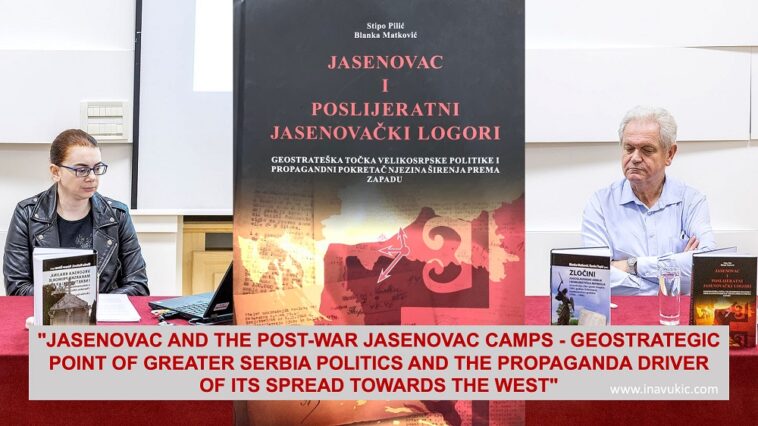It isn’t until you start reading the new book written in the Croatian language by Blanka Matkovic and Stipe Pilic “Jasenovac and the post-war Jasenovac camps – Geostrategic point of Greater Serbia politics and the propaganda driver of its spread towards the West” that you realise how much we need a book like this one at this particular time. At this moment, just over thirty years since Croatia seceded from communist Yugoslavia with the aim to transition from that totalitarian regime into democracy, only to still be wrestling with the communist fabrication of Croatian World War II history and various wild concoctions of victim numbers allegedly at the hands of Croats that float in the public space unchallenged by the official Croatia since year 2000 – as former communist operatives cling onto power with widespread corruption and deceit.
Also, this week is marking the 2022 commemorations for victims of World War Two Jasenovac Camps and the Croatian government, the President, the Jewish communities and other organisations cannot get together in one ceremony, but we are seeing, once again, several separate commemorations, clearly showing widespread disagreements regarding this part of Croatian history and how it should be commemorated. Were the truth of the camp being kept opened and operational after the war by communist Yugoslavia these commemorations at Jasenovac would honour all the victims who perished there not just the ones perished by April 1945!
Transition from the totalitarian communist regime into democracy for Croatia (and any other such country) was and is supposed to also be about correcting the history written by oppressive communists to reflect the truth. But this has not occurred yet, not to any noticeable degree as the governments support still the promulgation of communist mentality and the faceless denial of horrendous communist crimes. It is in the latter context that this book represents the long-awaited furthering of evidence of truth that in many ways serves as testimony to more communist crimes that have gone officially uncondemned and unprosecuted. Such efforts of historical research about Jasenovac camps have regretfully been left to private and personal pursuits of credible and renowned scientists and researchers without any government supports.
Two facts about the World War Two Croatian Jasenovac Camps that cannot be disputed are the wildly fabricated numbers of people that perished in the camp and that the camp was not shut down in May 1945. The latter is a particular focus in the second part of this book, and it seeks not only to point a spotlight on communist purges likely occurring within Jasenovac Camps walls after the war and victims of those murders either not reported or added to the fabricated numbers of victims the Independent State of Croatia was falsely and is still falsely burdened with.
Based on abundant and thorough historical research this Blanka Makovic and Stipo Pilic book is outstandingly truth revealing and draws significantly with evidence on the communist Yugoslavia hidden truth of the Jasenovac Camp being kept open after World War II ended in May of 1945 until 1952 and even until the 1960’s. This 640-page book published in 2021 by the Croatian Society of Historians – HPD “Dr. Rudolf Horvat” presents numerous public documents that have never been brought to the public attention, as well as maps and graphs, covering the period from the beginning of the 19th century to the present with emphasis on Jasenovac and Jasenovac camps, their role in Greater Serbia ideology and anti-Croatian propaganda.
And so, the book is based on exhaustive continuous research since 2006 and argumentation of material kept by archives and museums in Croatia, Slovenia, Bosnia and Herzegovina and the United Kingdom, so that the actual number of victims in Jasenovac could be determined, but also to raise awareness that the Jasenovac Camp was active not only until 1945 but also under the communist Yugoslavia rule when communist purges were rife and utterly vicious against patriotic Croatians, especially.
Given that we have all witnessed historical research results that prove the written or official history wrong referred to as revisionism, in a negative or unwelcome way this book, in its Introduction, aptly begins with the words James McPherson of Princeton once wrote while serving as the president of the American Historical Association: “Revision is the lifeblood of historical scholarship. History is a continuing dialogue between the present and the past. Interpretations of the past are subject to change in response to new evidence, new questions asked of the evidence, new perspectives gained by the passage of time. . . The unending quest of historians for understanding the past – that is, ‘revisionism’ – is what makes history vital and meaningful. Without revisionist historians, who have done research in new sources and asked new and nuanced questions, we would remain mired in one or another of these stereotypes.”
True to this quote Matkovic and Pillic have not only provided an abundant wealth of new documentation, new evidence that points out clearly that the history of World War Two Jasenovac Camp was strikingly different to what the world has been repeatedly told since May 1945 but they have offered suggestions and arguments that clearly direct us to the absolute need to further research on this topic especially because the written official history and research results since 1990’s, when state archives opened to the public after the break-up of former communist Yugoslavia, are at significant discord, thus creating incessant social divisions among the people as well as intolerance of the newfound but real truth. The Jasenovac Camp remains to be one of the most controversial topics in contemporary Croatian history and society. This is without doubt because the official Croatia has not dealt with World War Two Jasenovac Camp truth, or any other Croatian truth that fought to break away from Yugoslavia in that War because it suits former communists or their descendants in power not to pursue communist crimes, which also were evidently committed at Jasenovac Camps post-Word War Two until 1952 and into 1960’s.
Written well, with the flow that makes reading it compelling, with solid corroboration by way of events, names of people and detailed happenings the entire book, with its rich content and breadth of coverage, this book brings that period of Croatia’s history alive. When we couple all this then we know that this Matkovic and Pilic book is, so far, the most solid cornerstone upon which the Croatian truth will be revealed even more.
This book is a treasure chest for the Croatian truth that debunks with facts much what the Yugoslav communists have been feeding to their own people as well as the world. For example, there are numerous examples of manipulation of the number of victims that perished at Jasenovac camps and Matkovic emphasised during a book launch in 2021 that she found a file of Ante Pavelic, the head of the WWII Independent State of Croatia, in the Croatian State Archives, which contained a list of persons killed in the Jasenovac and Stara Gradiska camps. According to these data, 7,133 people died in Jasenovac, not counting men between the ages of 14 and 70, who are not listed in that list. In 1964, the Yugoslav authorities conducted research on the number of war victims throughout the former Yugoslavia, not counting those killed by partisans, the Yugoslav Army, the Communist Party and the Yugoslav regime. The number of victims was 597,323, which is much less than the imaginary number of Jasenovac victims fabricated by Yugoslav communists and Serbs and their collaborators in spreading lies and anti-Croatian propaganda.
Matkovic went on to say that it was Germany that forced Yugoslavia to make a list of Jasenovac victims due to reparations, which was declared a secret due to a large deviation from previous figures and remained unknown to the public until 1989, when Danas media outlet reported that about 60,000 people died in Jasenovac. The first unofficial exhumations in the Jasenovac area were carried out in 1961, and an official forensic investigation in 1964, but none of these excavations confirmed the theory of hundreds of thousands of victims of the Jasenovac camp fabricated largely by Serbs even to this day. Matkovic also warned that the remains found could have belonged to refugees, Croatian soldiers and civilians who were withdrawing from the country in May 1945.
The manipulation of the number of war victims, especially those from Jasenovac, was and still is an integral part of the Greater Serbia propaganda. This book demonstrates this so well.
Historian Pilic, co-author of this book , in his 2015 interview for the Croatian Cultural Council/HKV http://www.hkv.hr/hrvatski-tjednik/19485-s-pilic-komunisti-imali-logor-jasenovac-godinama-poslije-rata-i-u-njemu-je-bilo-likvidacija.html shed light on the post-war life of the Jasenovac camp and this book presents a more thorough and more detailed continuation of that. “We have already mentioned the name and surname of the manager of the post-war Jasenovac camp Anatoli Avramov in our original scientific article published in 2014, as well as the testimony of detainee Ivan Krizanovic and his ‘magnificent eight’ who escaped from Camp III-C in August 1946. central war camp Jasenovac, where they were housed. We also mentioned the son of the Thessaloniki volunteer Đuro Lavrnja, who ended up in the Jasenovac forced labour camp / prison in June 1946 for three months. There is also Antun Einfried, who escaped from that camp in November 1945 and whose further fate is unknown. In front of the camp, the guards also killed a local Jasenovac Serb, a local pig keeper Vladimir Trivuncic. Pre-war and war gunsmiths were also killed there, as well as detainees of the Jasenovac war camp, Marko Radic and Josip Batarelo. For the latter, there is a document on release from the Ustasha Jasenovac camp, and for the former there are several documents on the liquidation in Jasenovac, and yet, both are still on the falsified victim list of the Memorial Centre Jasenovac. This was, and remains, the main problem of ‘official’ Croatian historiography, which cannot be reconciled with the documents of the party and state Yugoslav communist authorities that they had camps and execution sites and post-war cemeteries in the area after the war, it is no exaggeration to say that there are ‘historiographical bombs’ in the book – documents that speak of the existence of camps and camp sites until the sixties.
When it comes to camps and their existence, operation, and functioning, we found that in Jasenovac area there were two basic types of camps: camps for prisoners of war, captured soldiers of other countries, and camps for convicts, captured and convicted locals, soldiers and civilians as collaborators of the occupiers. As early as 1945, the central camp, i.e., the administrative centre of all domestic convicts, was the Stara Gradiska camp / prison, as was Camp III-C Jasenovac during the war. From that camp, in the future, convicts were assigned to jobs, labour camps, convict work sites throughout Croatia and Yugoslavia.
Camps / prisons existed permanently or occasionally in the area until the early 1960s, when all land around Jablanca and Mlaka was handed over to the Jasenovac Agricultural Cooperative. Thus, for example, from September 24, 1956 to September 29, 1958 in Jablanc, Šime Lončar, son of Ivan Lončar and brother of Ivan Lončar, still alive today the well-known Yugoslav diplomat Budimir / Budislav Lončar, which speaks of the continuity of these camps / prisons and what the convicts did in them. And according to the oral testimonies of the inhabitants of Jasenovac Posavina, the older son of Josip Broz Žarko often came to that hunting ground.
We also established on the basis of documents that no later than February 1946, Camp III-C Jasenovac was under the supervision of the Ministry of the Interior, and until then it was under the supervision of the Ministry of Industry and Mining. Based on the available documents, we determined the movement of the number of convicts in the Stara Gradiška camp / prison from 1946 to 1950, as well as the movement of the number of deaths in the same camp from 1945 to 1952 according to available camp / prison documentation. These numbers may not be entirely accurate, but they show that the administration was guided by that as well.
We also found studies that were made for the purpose of closing that camp / prison after 1964, which was abandoned due to the famous conflict in 1966 between the two first men and their people at the time…”
At the book launch in Mostar, Bosnia and Herzegovina, in 2021 its co-author Stipo Pilic said that “since the middle of the 19th century, Jasenovac has become the focal point of Serbian conquests to the west and the second part of the book deals with that, as well as how this policy works propaganda to this day and what are the answers of Croatian politics and diplomacy, but also non-transparent and unclear “, while co-author Blanka Matkovic pointed out that this book tries to deepen the scientific work on the post-war Jasenovac camp as well as on Jasenovac as a settlement and camp. In this, besides the significant wealth of historical evidence and interpretations this book feels like the solid steppingstone and foundation for the assertion of truth worldwide about the post- WWII communist Yugoslavia Jasenovac camps. The camps did not close on 22 April 1945 as even the United States Holocaust Memorial Museum claims, but it continued operations for the purposes of implanting the cruel and oppressive communist regime in Yugoslavia. But then, regretfully, Holocaust Memorial Museums, Yad Vashem etc. have “taken as gospel” it seems the words written on Jasenovac history by even Jewish communist collaborators and sympathisers.
A copy of this very valuable book may be obtained by contacting the Croatia Rediviva website http://croatiarediviva.com/kontakt/
Ina Vukic




